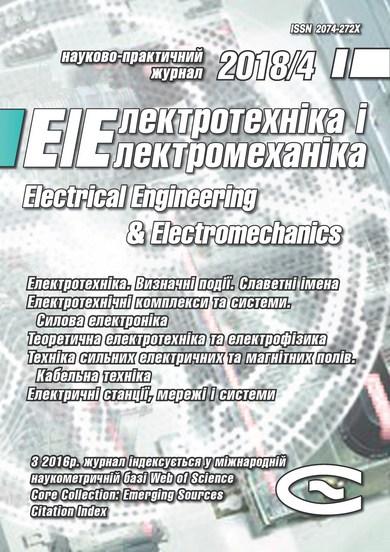CALCULATION OF THE EQUIVALENT ELECTRICAL PARAMETERS OF THE INDUCTOR OF INDUCTION CHANNEL FURNACE WITH DEFECTS IN ITS LINING
DOI:
https://doi.org/10.20998/2074-272X.2018.4.05Keywords:
equivalent electric parameters, mathematical modeling, induction channel furnace, defects of lining, diagnostics of the lining stateAbstract
Aim. The aim of the paper is to determine a quantitative relationship between measured impedance of the inductor and the electrical characteristics of the separated melt circuit parts for the determination of the place of a liquid metal leakage and for the improvement in such way the diagnostic system of lining state of induction channel furnaces. Technique. The study was performed on the basis of the concepts of theoretical electrical engineering, mathematical physics, and mathematical modeling. Results. Using two equivalent electrical circuits of the inductor the analytical expressions and graphical dependencies, which determine a quantitative relationship between the parameters of the separated parts of a liquid-metal circuit and the impedance of the whole inductor measured in practice, for the presence of different lining defects, were found. The method for calculating the increments of equivalent electrical parameters of the inductor as a function of increments of the parameters of the secondary liquid-metal circuit was proposed. Scientific novelty. It is proved that for small changes (less than 10 %) of the parameters of the liquid-metal circuit, it is expedient to use a linear relationship between its increments and to create the sensitivity matrix, which clearly shows the presence of a strong or weak interrelation between the disturbed values of the parameters of the secondary circuit and the inductor. Practical significance. The use of this technique allows to develop the database for various types of lining defects for a given furnace and on its basis to predict the places of a melt leakage and the state of furnace lining owing to periodical measurements of the inductor parameters.References
1. Rudnev V., Loveless D., Cook R. Handbook of induction heating. CRC press, 2017. 736 р.
2. Vivek R. Gandhewar, Satish V. Bansod, Atul B. Borade. Induction Furnace – A Review. International Journal of Engineering and Technology, 2011, vol.3, no.4, pp. 277-284.
3. Lucia O., Maussion P., Dede E.J., Burdio J.M. Induction Heating Technology and Its Applications: Past Developments, Current Technology, and Future Challenges. IEEE Transactions on Industrial Electronics, 2014, vol.61, no.5, pp. 2509-2520. doi: 10.1109/TIE.2013.2281162.
4. Jin S., Harmuth H., Gruber D. Thermal and thermomechanical evaluations of channel induction furnace applying strong insulation containing lightweight aggregates. Ironmaking & Steelmaking, 2017, pp. 1-5. doi: 10.1080/03019233.2017.1291153.
5. Zolotarev V.M., Shcherba M.A., Zolotarev V.V., Belyanin R.V. Three-dimensional modeling of electromagnetic and thermal processes of induction melting of copper template with accounting of installation elements design. Technical Electrodynamics, 2017, no.3, pp. 13-21. doi: 10.15407/techned2017.03.013.
6. Asad A., Bauer K., Chattopadhyay K., Schwarze R. Numerical and Experimental Modeling of the Recirculating Melt Flow Inside an Induction Crucible Furnace. Metallurgical and Materials Transactions B, 2018, vol.49, no.3, pp. 1378-1387. doi: 10.1007/s11663-018-1200-4.
7. Lope I., Acero J., Carretero C. Analysis and Optimization of the Efficiency of Induction Heating Applications With Litz-Wire Planar and Solenoidal Coils. IEEE Transactions on Power Electronics, 2016, vol.31, no.7, pp. 5089-5101. doi: 10.1109/TPEL.2015.2478075.
8. Pham H.N., Fujita H., Ozaki K., Uchida N. Dynamic Analysis and Control for Resonant Currents in a Zone-Control Induction Heating System. IEEE Transactions on Power Electronics, 2013, vol.28, no.3, pp. 1297-1307. doi: 10.1109/TPEL.2012.2210286.
9. Zolotaryov V.M., Shcherba M.A., Belyanin R.V., Mygushchenko R.P., Kropachek O.Yu. Comparative analysis of electrical and thermal control of the lining state of induction apparatus of copper wire manufacture. Electrical engineering & electromechanics, 2018, no.1, pp. 35-40. doi: 10.20998/2074-272X.2018.1.05.
10. UPCAST®, Finland. UPCAST technical documentation Available at: http://www.upcast.com (accessed 12 May 2017).
Downloads
Published
How to Cite
Issue
Section
License
Copyright (c) 2018 A. D. Podoltsev, V. M. Zolotaryov, M. A. Shcherba, R. V. Belyanin

This work is licensed under a Creative Commons Attribution-NonCommercial 4.0 International License.
Authors who publish with this journal agree to the following terms:
1. Authors retain copyright and grant the journal right of first publication with the work simultaneously licensed under a Creative Commons Attribution License that allows others to share the work with an acknowledgement of the work's authorship and initial publication in this journal.
2. Authors are able to enter into separate, additional contractual arrangements for the non-exclusive distribution of the journal's published version of the work (e.g., post it to an institutional repository or publish it in a book), with an acknowledgement of its initial publication in this journal.
3. Authors are permitted and encouraged to post their work online (e.g., in institutional repositories or on their website) prior to and during the submission process, as it can lead to productive exchanges, as well as earlier and greater citation of published work.





